Last Updated on October 5, 2025 by George Joseph
A sprawling architectural structure, embellished with elegant sculptures and divine images and figures. That’s Madurai Meenakshi temple in Tamil Nadu, spread across a majestic complex and an iconic landmark of the city. The temple is equivalent to a fifteen-story tall building, with captivating artistry that entices tourists from different parts of the world. Almost 20,000 devotees and visitors come to the Madurai Meenakshi temple to offer their prayers and appreciate the sculptures.
ALSO SEE- Top 10 Tourist Places in Tamil Nadu (Complete List)
Madurai Meenakshi temple portrays the religious and eloquent traditions of the southern part of India. High walls, numerous towers, vast spaces, gateways, 1500 images and sculptures of Gods, Goddesses, and other deities on the outside walls, 30000 sculptures inside the inner premises, sanctuaries, and shrines.
Spread across a massive space of 70,000 square feet, Madurai Meenakshi temple is a combo of masterpiece architecture and celestial bliss. It is one of the oldest and largest temples in India.
ALSO SEE – Top 17 Famous Temples in Kerala
The Legend of Meenakshi in Madurai Meenakshi Temple
In Hindu mythology, there is a story behind the legend of Meenakshi. Meenakshi is said to be the reincarnation of Goddess Parvati.
Malayadhvaja, the Pandya king, and his consort queen Kanchanamalai wished for a son who could be the heir of the kingdom. He performed a Yagna, the fire ceremony, as a worship to the Gods to fulfill his wishes. But instead of a son, a daughter was born to him who unusually had three breasts. He named his daughter Meenakshi but was worried about her. The Gods assured him that his problems will be solved if he raised her like a son to be a warrior and once she meets her true love, her third breast will vanish.
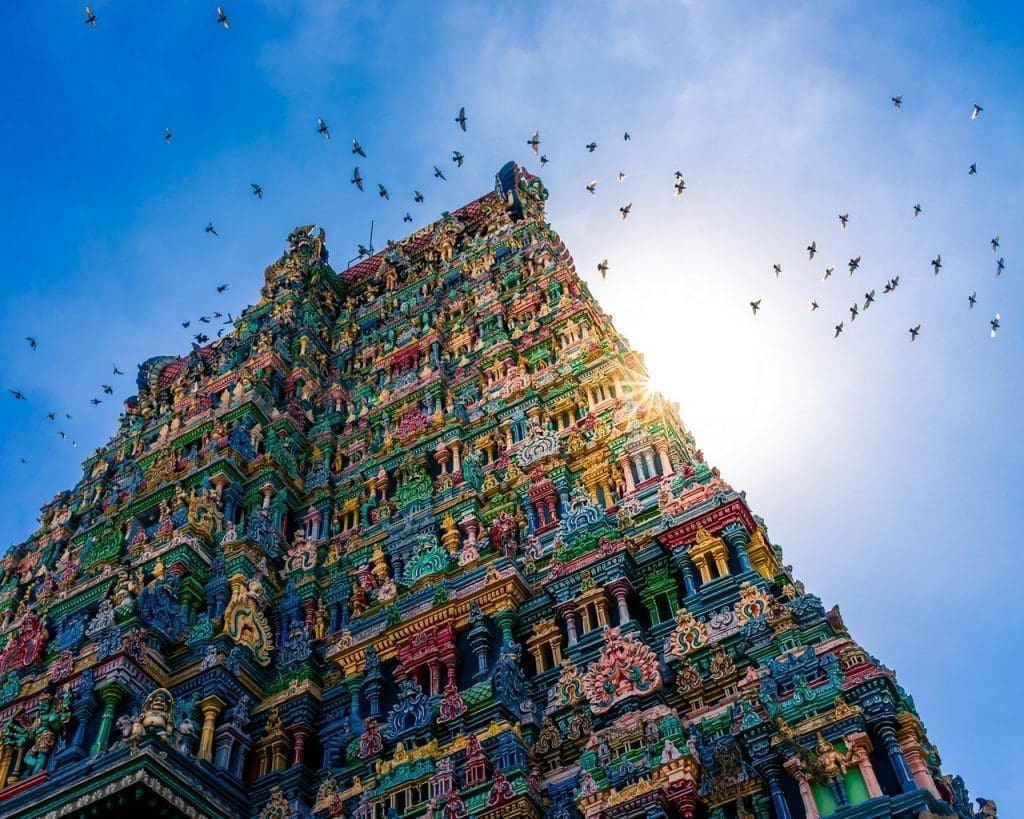
Malayadhvaja followed the instructions of the Gods and raised Meenakshi like a son and she turned out to be a great warrior, winning several battles. Once when she was on a battlefield, she was challenged by Lord Shiva. The moment she saw Him, her breasts disappeared. Destiny was finalized at that moment. Meenakshi and Lord Shiva were married, the marriage being presided over by Lord Vishnu. The couple stayed in Madurai and ruled the kingdom as king and queen. The wedding ceremony is celebrated even today as ‘Chithirai Thiruvizha’.
The History behind the Madurai Meenakshi temple
The initial structure of the Madurai Meenakshi temple was constructed in the 7th century C.E. The temple was further renovated and re-constructed between the 16th and 17th centuries under the flagship of the Nayak dynasty. The complex was further increased and the streets around the temple were redesigned, keeping in mind the principal and traditional architectural designs of Vastu Shastra.
The Intricate Architecture of the temple
Madurai Meenakshi temple follows the Dravidian style of architecture, prevalent in the southern part of India. The main essence of the style is the towers, covered porches, halls with pillars, and water reservoirs.
Lord Shiva is known here as Sundareshwara in the colloquial language, the meaning being beautiful Lord. There are two principal sanctuaries in the temple, right in the middle of the entire complex. One is dedicated to Meenakshi and the other to Sundareshwara. Each sanctuary has a gold finial cap. There is a Mandapa in front of the sanctuaries, which provides the path to the Garbagriha.
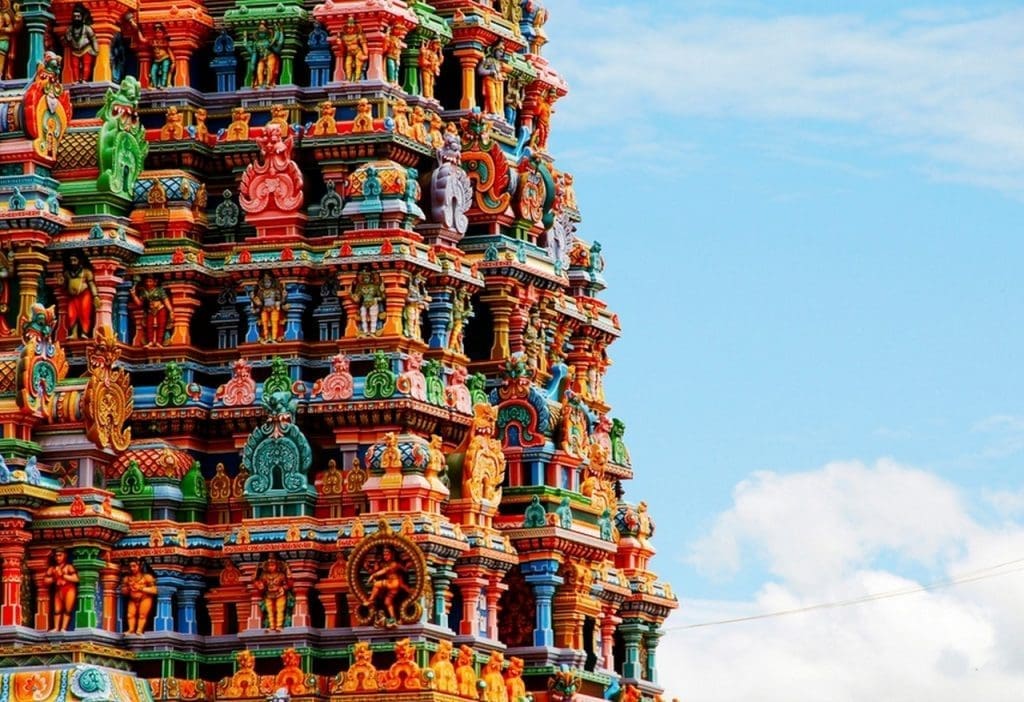
Before entering the sanctuaries, the devotees believe it is holy to dip into the holy waters of the Golden Lily tank. You can find the tank on the southern side of the temple complex. The tank is believed to be the place where a golden water lily bloomed for the puja conducted by Lord Indra. At the northeast corner of the complex, you can see the Mandapa and the Hall of Thousand pillars.
The Hall of Thousand Pillars
The Hall of thousand pillars is one of the most impressive and significant parts of the Madurai Meenakshi temple. Though the name is thousand, in reality, there are 985 pillars. The structure is a brilliant piece of architecture, carved out of a single rock. The hall is also known as Aayiram Kaal Mandapam.
You will find huge statues of Nataraja and Sivakama inside the hall, the largest in the temple. Images of gods, demons, and animals of the celestial world are carved on the stone pillars, portraying an artistic charm. In the yesteryears, the hall was used mainly for musical shows, religious dances, or for the king to address the people.

Nowadays, the hall has been converted into a museum for visitors to witness several artifacts like bronze sculptures, various paintings, and objects depicting the history of the temple, antique coins, rare photographs, several idols, and exhibits belonging to the Shaiva and Vaishnava religions.
ALSO SEE – Guruvayoor temple-Timings and How to plan your darshan?
Ashta Shakti Mandapam
One of the most enchanting parts of the Madurai Meenakshi temple is the Ashta Shakti Mandapam. The hall essentially served the purpose of offering food to the devotees who came for worship. It was established by the wives of Thirumalai Nayakar. The pillars and walls of the Mandapam comprise images and sculptures from the tales of the lives of Lord Shiva and Goddess Meenakshi
The Gopuras
The huge towers of the Madurai Meenakshi temple are known as the Gopuras. They serve as the entry gates for the temple and are ornate with elegant architecture. The temple has fourteen Gopuras at each of the cardinal directions. The interesting part of the Gopuras is the height of one tower exceeds the other ahead of it, the reason being the towers were added by the succession of rulers to show off their power and devotion.
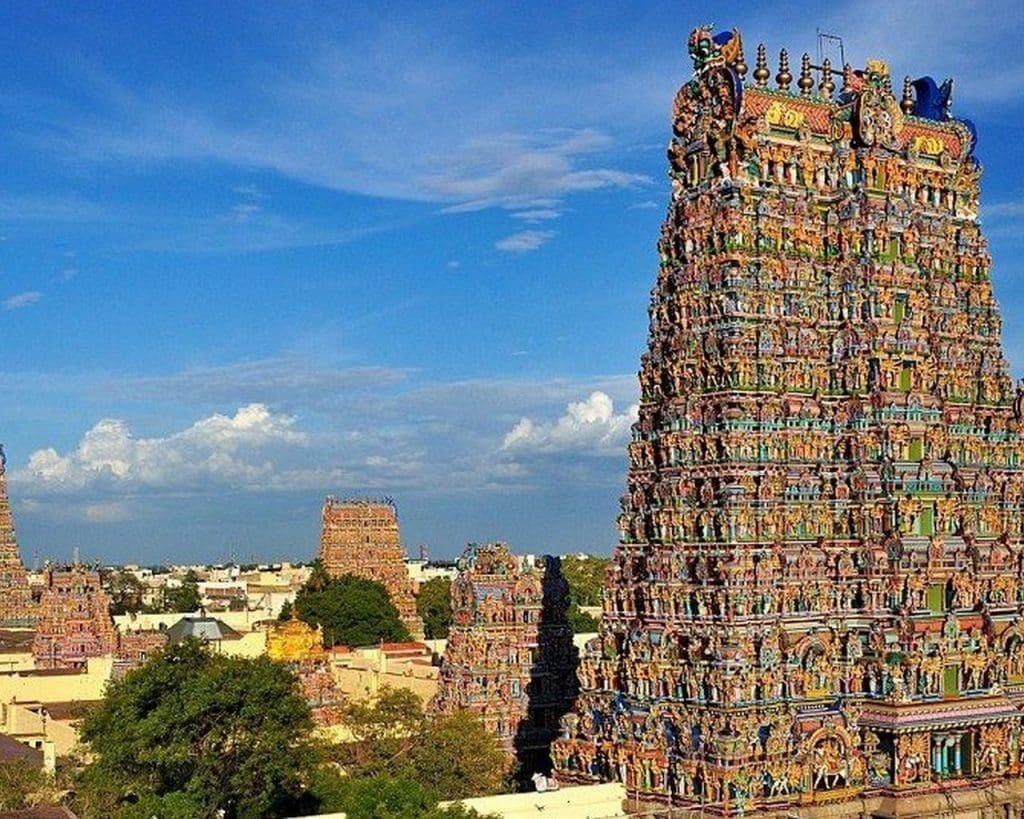
The tallest of the towers is almost 170 feet tall. It contains more than 1500 figures, renovated and repaired after every twelve years.
Festivals at the Madurai Meenakshi temple
Many festivals are held in the temple almost throughout the year. The major among them is the Chithirai Thiruvizha or Thirukalyanam festival, held in April every year. The festival attracts millions of devotees and visitors during the festival. It essentially celebrates the divine union of Lord Shiva and Goddess Meenakshi. It is an opportunity to witness the tradition, history, and cuisine of the Tamilian culture.
The other prominent festivals held at the Madurai Meenakshi temple are the Vasantham festival, Unjal festival, Mulai-Kottu festival, Arudhra Dharsan Festival, and Thai Utsavam. Besides, there is the Navratri festival where you will love to watch the Gollu or the colorful dolls displayed in the temple. All the festivals are celebrated with much zeal and enjoyment.
Evening ceremony or the Palliarai Puja
The last puja at the temple is held every day at 9:15 pm and is called the Palliarai Puja. The idol of Lord Shiva is placed on a palanquin and carried around the temple in rounds followed by the Thakil and Nadaswaram musical instruments played in harmony. The idol is placed near the shrine of Goddess Meenakshi and the puja rituals are performed.
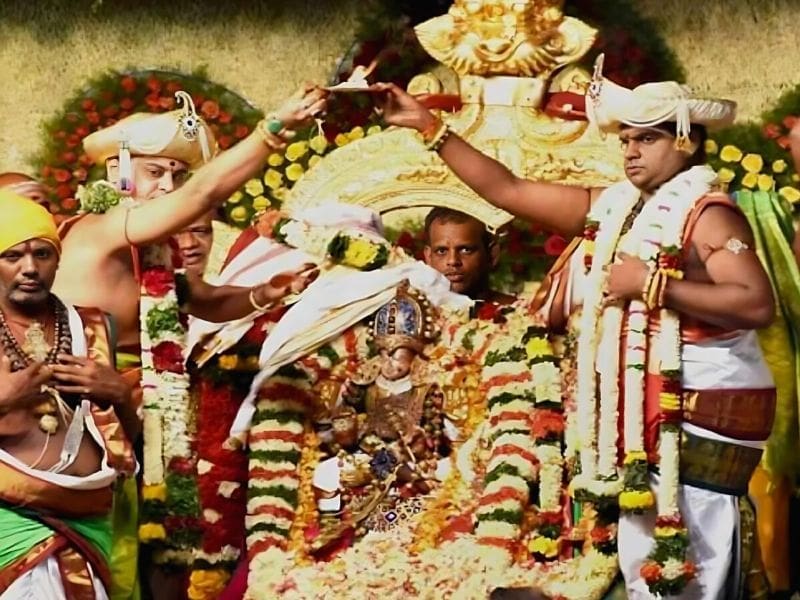
The idols of Lord Shiva and Goddess Meenakshi are placed in a swing to celebrate the divine bonding between them.
Madurai Meenakshi temple- Timings
The Puja and Darshan timing for the morning is between 5 AM to 12:30 PM and for the evening is from 4 PM to 11 PM.
For Hindus, the charges for the darshan are free and others can opt for free darshan or INR 50 per person for a special darshan.
What is the best time to visit the temple?
The temple can be visited at any time of the year. But it is recommended to visit the temple when the weather is pleasant and comfortable. Yet the best time to visit the temple is between October and March when the weather is at its best. The months of July and August are also pleasant due to the monsoons and can be opted for a trip to the temple. But if you are eager to attend the Chithirai festival, then it is better to visit during April and May.
ALSO SEE – Top 9 Food in Kerala To Try in 2023 When you travel
How to reach the temple?
By Air: The nearest airport is Madurai, from where you can avail a cab for a drive of about 90 minutes to the temple.
By Rail: The nearest railway station is Madurai junction from where the temple is 10 minutes away. You can board a cab or avail an autorickshaw to reach the Madurai Meenakshi temple.
By Bus: The nearest bus stand is Mattuthavani. From the bus stand, the travel time is 20 minutes by cab.
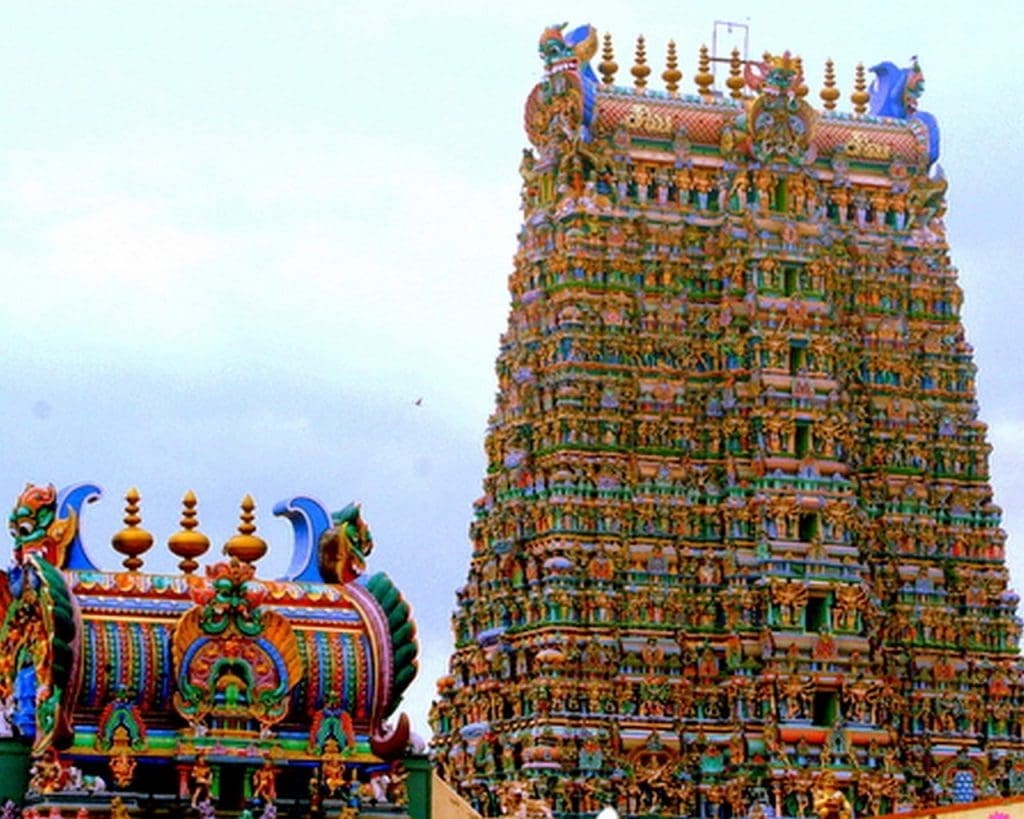
Important Points to note
- Check the temple website about the puja timings and prices before reaching
- Follow the dress code of the temple, covering both legs and shoulders. Do not wear dresses, shorts, caps, lungis or even socks
- Wallets, belts made of animal skin, sticks, umbrellas, cameras, and mobile phones are not allowed inside the temple
Meenakshi temple is the finest example of India’s exemplary architectural design and charm. It is amazing to watch its majestic and artistic beauty, a wonder for visitors from all around the world.

Leave a Reply